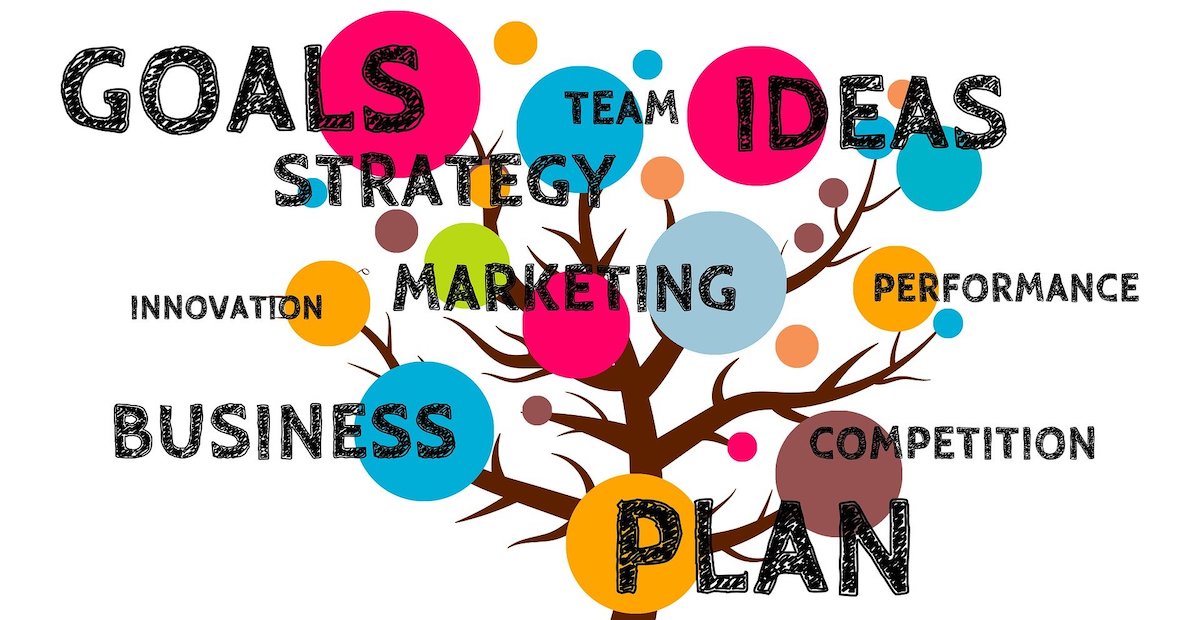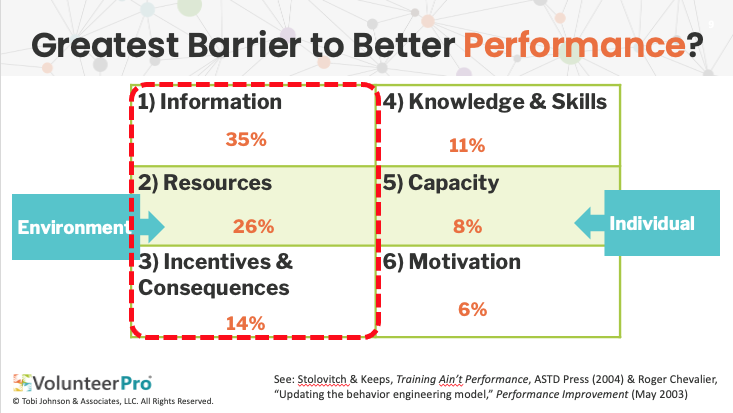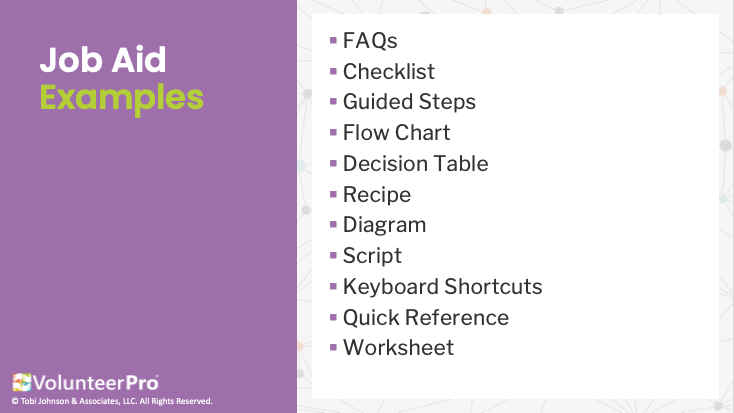Unlocking the Mystery of
High-Impact Volunteer Performance
When we struggle to inspire deep commitment, follow-through, and high levels of volunteer performance, we often assume that it’s all about finding the right people.
That some people are productive, and others are not. And, that if we can just attract the right people, we will achieve a high functioning team that can work independently with little or no support.
But this assumption assumes that volunteer performance is entirely innate. In other words, you are either born with the ability to do the job or not.
But that could not be further from the truth.
In fact, it is more the environment than the individual that determines success.
Workplace Productivity Basics
There have been plenty of workplace productivity studies over the years. Many can be applied to the volunteer context.
Thomas Gilbert, considered by many to be the “father of performance improvement,” developed a human productivity model based on “behavior engineering.”
His bespoke Behavior Engineering Model (BEM) helps identify barriers to individual and organizational performance. It was first shared in 1978 and has been updated in subsequent years to better pinpoint key drivers of performance.
This model, outlined in his now-classic book Human Competence: Engineering Worthy Performance, illustrated key drivers of productivity in people, regardless of the environment or whether the work is paid or unpaid.
So, it can apply to volunteers, too.
Gilbert identified the six aspects of behavior that must be present to achieve optimal performance. They are aligned with two domains – the environmental and the individual.
Gilbert’s Behavior Engineering Model (BEM)
Research has shown that up to 85% of performance issues are caused by something in the work environment. And when asked, 70-80% of workers identify environmental factors as their own greatest barrier to better performance.
So, when it comes to designing an optimal workplace for volunteers, the context should be considered first.
In addition, lackluster volunteer performance stems from a combination of influences. Below are a few questions to ask to begin to diagnose your barriers to success.
Environmental Factors
- Data
- Do team members know how they are doing?
- Are they clear on the expectations are for their work?
- Do they receive frequent, relevant feedback about the quality of their performance?
- Do they have clear guidelines about how to meet expectations?
- Resources
- Do they have sufficient tools, resources, time, and materials to do the work? (i.e., is there proper software, is there enough time to complete the task, etc.)
- Are the standard processes and procedures clearly defined? Do they support the desired outcomes?
- Does the work environment support the work being done as expected? (i.e., is it organized, safe, free of barriers, etc.)
- Incentives
- Are there non-monetary incentives that reward performance?
- Are there personal or career development opportunities available?
- Are there consequences for inferior performance?
Individual Factors
- Knowledge
- Is training developed that matches the requirements of exemplary performance?
- Do people have the minimum-required knowledge, skills, and experience required to learn how to do the work successfully? (i.e., ability to use basic computer functionality)
- Are people appropriately placed in roles to apply their new or existing knowledge, skills, and experience?
- Capacity
- Is there flexible scheduling to match peak capacity?
- Are people recruited to match the skills and requirements of the work?
- Are their job aids and other tools to offer just-in-time performance support?
- Motives
- Do the people’s motives align with the work?
- Are people recruited to match the realities of the situation?
In addition to Gibert’s model, researchers have also found that a focus on fostering a positive workplace culture can boost productivity and engagement. Alternately, disengaged workers have 37% higher levels of absenteeism, 49% more accidents, and 60% more errors.
We have also written extensively about how personal mindsets – in the form of limiting or enabling beliefs – as well as volunteer leadership approaches play into the ultimate results that teams can achieve.
These can all be considered.
Volunteer Performance: Management Support and Interventions
When it comes to volunteers, what do you think is the greatest barrier to better performance?
Consider Gilbert’s six domains of on-the-job performance. Which are the greatest barriers to better results for your team?
Is it information, is it a lack of adequate resources? Is it incentives and consequences? Is it knowledge and skills? Is it capacity, or is it motivation?
In most cases, the key drivers of performance stem from our environment instead of our individual innate abilities.
Volunteer Performance Intervention Ideas
When designing for productivity, organizations often believe that paperwork (i.e., volunteer agreements, waivers, manuals, standard operating procedures, and rules) ensures that our volunteers will be more productive or that they follow through more.
However, research shows that rules and agreements are not the key driver of volunteer productivity in the workplace.
Rather, what supports productivity is information, resources, incentives, and consequences. So, we want to look at the environment, rather than Individual skills or temperament.
In other words, stop trying to fix the individual when you can fix the environment.
So, volunteer organizations can and should plan a variety of actions to support volunteer performance beyond traditional approaches.
When it comes to volunteer productivity, you may consider redesigning your training (see our Ultimate Guide to the Training of Volunteers to get started). Better volunteer training is a start, but performance improvement can include much more.
Management support and interventions that you can choose from training is part of it, but it could be a redesign. It could be resources. It could be technical support. It could be incentives. It could be the elimination of certain tasks.
One of the most helpful and effective ways to support volunteer performance is by providing well-designed job aids for volunteers. A job aid is simply a document or device that helps the user complete a job.
These might include checklists, flowcharts, cheat sheets, reference tools, desk manuals, or even tutorials or information inside (or linked to) your software platform.
Job Aids to Help Volunteers Succeed
Combine Tactics for Better Volunteer Productivity
Management interventions and re-designs of the work context can have an impact on volunteer performance. With a more purposeful approach, you can begin to create an environment where volunteers can be more productive, and the teams can better work together.
If you are struggling to cultivate a high-performing volunteer team, first assess your current situation. What are the current barriers to success? Ask your volunteers for their perspective. You will learn a lot by listening.
Then, revisit some of the ideas outlined in this article. Convert them into a combination of tactics that can offer better volunteer support and thus better results.
This is the art of management – making decisions about how to improve your team’s outcomes through the appropriate support at every step of their journey.
And volunteers will thank you for reducing the speed bumps to success and helping them make the world a better place with fewer frustrations, less effort, and greater satisfaction.
Design a Better Volunteer Workplace: Our Free Online Course
In our VolunteerPro Volunteer Management Academy, we have a FREE mini-course that explains what it takes to become an “architect of experience” and realize success for your volunteer team.
In this short lesson, we share how to harness the science of trust for better supervision and deepen connections with volunteers through purposeful strategy.
You’ll also get two helpful downloads to support your success:
- [Worksheet] The Miracle Mindset
- [Cheat Sheet] Five Common Myths & Mindsets About Volunteers











